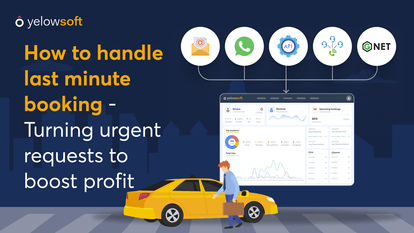The taxi industry is evolving at an unprecedented pace.
If you're still depending on manual processes or outdated tools, you most likely are wasting time and money without even realizing it.
Taxi dispatch software can change that. It gives you control, clarity, and speed. Exactly the weapons that you need to stay ahead and grow in a tough market.
In this blog, we will learn about why saving time and money matters in the taxi business and ways taxi dispatch software helps you achieve it.
Why saving time and money matters in the taxi business
Time and money are everything for any business. The longer it takes to assign a ride, the more trips you lose. Unplanned delays? They cost fuel and hurt the customer experience. Manual errors? They lead to billing issues and unhappy clients.
With rising fuel prices, vehicle maintenance, and driver expectations, businesses can no longer afford to be inefficient. Saving time and money means,
- more completed rides
- satisfied customers
- healthier bottom line
It also helps you beat the competition that's already using smarter systems.
Proven ways to save time and money with taxi dispatch software
We now know how crucial it is to save time and money for taxi businesses. We also know how positive its impact is on taxi operations. Now let’s see how you can save it by using taxi dispatch software.
Automated dispatching
Instead of relying on dispatchers to match drivers and passengers manually, the system does it in seconds. It dispatches the nearest available driver based on location, availability, and vehicle type.
Automated dispatching reduces wait times, keeps drivers moving, and avoids idle minutes. You save the dispatcher’s time, cut down on missed trips, and serve more customers with the same fleet. More trips in less time means better revenue and happier passengers.
Trip management
Trip management is a key feature of taxi dispatch software that helps streamline every ride from booking to drop-off. It allows dispatchers to,
- assign trips efficiently
- track live locations
- monitor driver availability in real-time
With simplified trip management, businesses save both time and fuel costs. It also reduces manual errors and improves operational accuracy.
Overall, trip management ensures smoother rides, better customer experiences, and significant cost savings for taxi businesses.
Ride broadcasting
Ride broadcasting instantly sends new ride requests to multiple nearby drivers at the same time. This increases the chances of quicker acceptance and faster pickups. Instead of assigning manually, the system automates the process, reducing dispatcher workload and response time.
It helps avoid idle time, improves fleet efficiency, and ensures better coverage during peak hours. By speeding up trip allocation, ride broadcasting saves valuable time and helps taxi businesses cut down on operational costs.
Heatmaps for high-demand zones
Heatmaps show you where the ride demand is highest so that you can send more drivers to those areas and get more bookings.
This avoids idle time and increases the number of rides per shift. Drivers earn more, and you earn more too.
You also serve more customers without increasing the fleet size. It’s a smart way to increase the efficiency of your resources.
Driver performance monitoring
You can monitor driver performance and check how your each driver is performing. From on-time passenger pickups to the number of trip completions, everything can be tracked, monitored, and evaluated easily.
This helps identify top performers and, more importantly, guides those who need improvement.
You can spot patterns early, avoid future issues, and run a more reliable service. Better drivers mean better service. And better service means better business and fewer customer complaints.
Real-time vehicle tracking
With live navigation and GPS tracking, you always know where your vehicles are. This way it becomes easy for you to spot them when there are delays. By always having your eye on your fleet, you can manage it in a better manner.
You can also update customers with accurate ETAs (estimated time of arrival). It builds trust and allows you to make quick decisions. If a car is stuck or idle for too long, you can take corrective action. It helps keep every ride flawless, on time and well-managed.
Centralized admin dashboard
Taxi dispatch software’s admin dashboard shows you everything: rides, drivers, payments, documents, and many other crucial things. You don’t need to check multiple systems or call staff for updates. Instead, you can use this valuable time to focus on something more important.
You get full control of your taxi operations in one place. The more organized your system is, the less time is spent fixing small problems.
Smart shift planning
Planning driver shifts manually is a headache. You risk under or overstaffing. With smart scheduling, you plan shifts based on demand, past trends, and availability. This reduces idle drivers and missed bookings.
You get the right number of drivers at the right time. It also keeps drivers happy by avoiding last-minute changes. Balanced shifts mean smoother operations and better customer service.
Reduced cancellations and no-shows
Smart taxi dispatch software reduces the chances of ride cancellations. Drivers get proper trip info and reminders, and passengers get updates. This keeps both sides informed and reduces last-minute dropouts.
Fewer cancellations mean fewer wasted resources. It improves efficiency and keeps your schedule tight. That adds up to more completed rides and better overall revenue.
Conclusion
Taxi dispatch software does more than manage bookings. It improves how your business runs, day in and day out. By automating routine tasks and providing real-time insights, it saves valuable hours and reduces unnecessary costs.
From better route planning to faster billing and fewer no-shows, the benefits are clear. In a market where speed and service matter most, this is the tool that helps you stay sharp, efficient, and profitable, without working harder to get there.
Ready to save your time and money with Yelowsoft’s taxi dispatch software?




